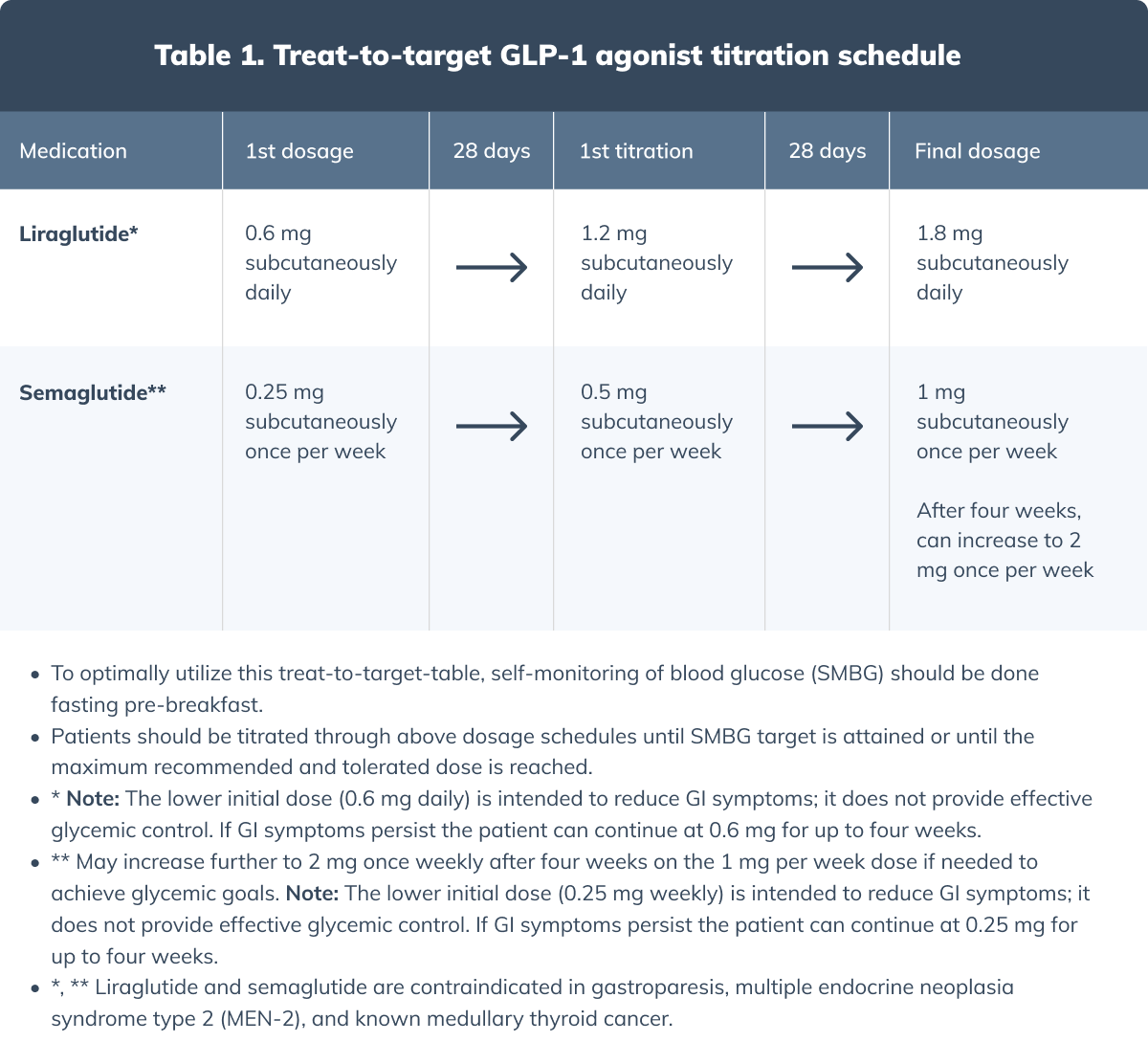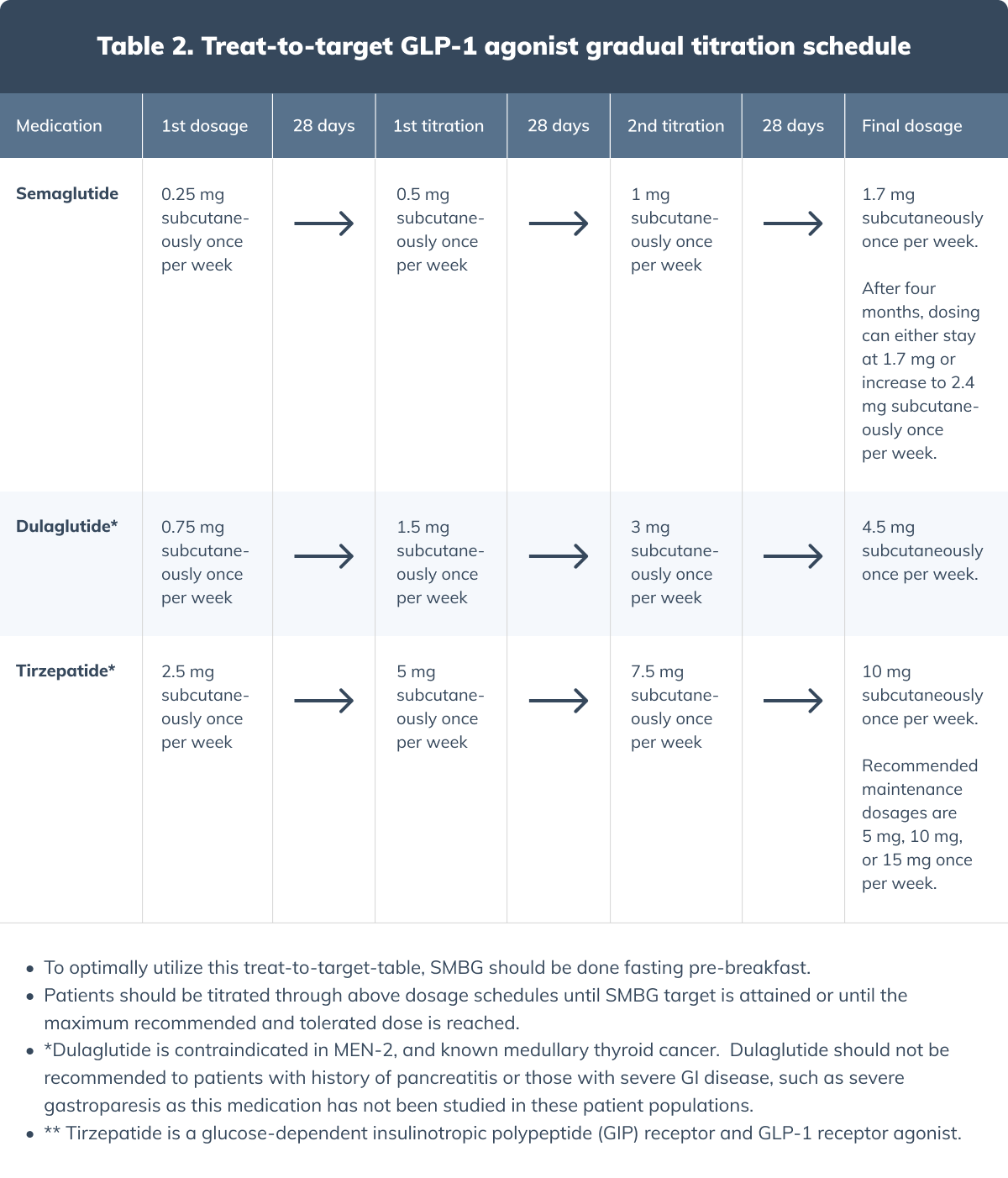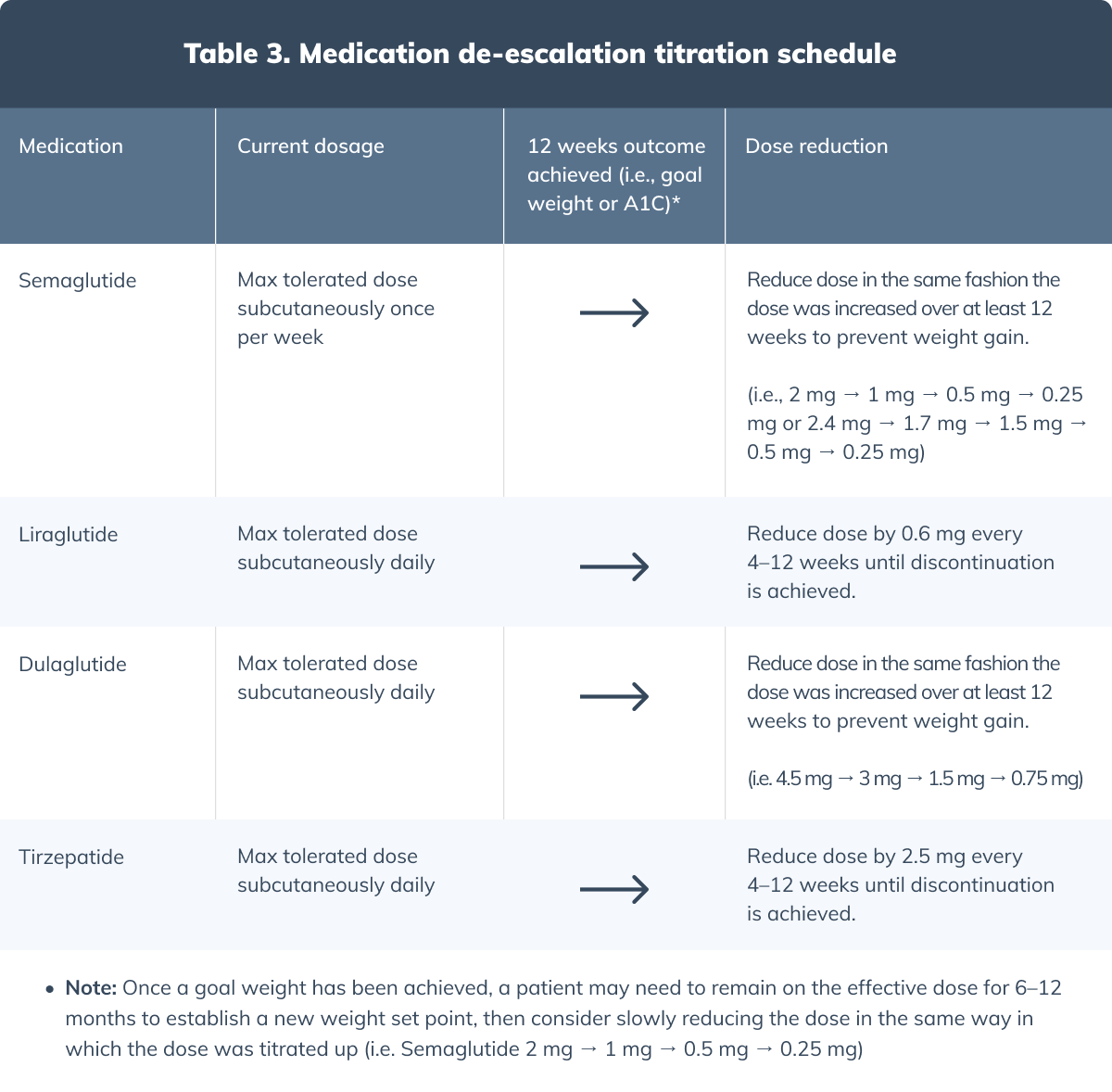OvationLab Lowest Effective Dose GLP-1 Medication and De-escalation
Protocol development in integrative medicine is not typically a simple process. Individuals require individualized care, and what works for one patient may not work for another.
To establish these protocols, we first developed a Rating Scale that could be used to discern the rigor of evidence supporting a specific nutrient’s therapeutic effect.
The following protocols were developed using only A through D-quality evidence.
This template, developed in partnership with OvationLab, is intended to help establish and maintain the lowest effective dose of GLP-1 receptor agonist therapy, ensuring optimal glycemic control while minimizing side effects. Titrating to the lowest effective dose is critical to achieving therapeutic outcomes while reducing the potential for gastrointestinal (GI) symptoms and other adverse effects.
De-escalation, or dose reduction, may be considered in patients achieving sustained glycemic control, while maintaining efficacy. Continuous monitoring will guide dose adjustments to ensure an individualized approach for each patient.
Lowest effective dose of GLP-1 prescription
When prescribing GLP-1 receptor agonists, it’s essential to titrate to the lowest effective dose to achieve optimal therapeutic outcomes while minimizing side effects. The initial dose of 0.5 mg weekly is primarily intended to reduce GI symptoms and help the body adjust to the medication. It’s important to note that this starting dose does not provide effective glycemic control, and gradual dose adjustments should be made to reach the appropriate therapeutic level.


De-escalation/tapering off GLP-1 medication
The de-escalation of GLP-1 medications, such as semaglutide and liraglutide, can be tailored to individual patient needs by adjusting the weekly or daily dose reduction based on their current dosage. The general principle is to reduce the dose gradually over several weeks to allow the patient’s body to adjust, while continuing to implement nutrition and lifestyle shifts.

Foundational supplementation
Protein
Start with a general dose of 10–20 g daily of plant-based or whey protein (although dosages are typically in the 20–40 g range).
- Healthy adults engaging in minimal physical activity should aim for at least 0.8 g of protein per kg of body weight per day to meet the recommended dietary allowance (RDA) of protein to avoid deficiency. This translates to about 10–15% of total daily energy expenditure.
- Daily protein intake should be adjusted depending on age, physical activity, and metabolic health goals. Studies suggest that a high-protein diet consisting of 1.07–1.6 g of protein per kg of body weight daily (27–35% of total daily energy expenditure) provides enhanced weight-loss effects while preserving fat-free mass. (Bray 2024)(Moon 2020)
- GLP-1 secretion is enhanced by all forms of dietary proteins—from whole proteins to peptides and amino acids—each interacting with unique or unknown cellular mechanisms based on their structure. (Hira 2021)(Miguéns-Gómez 2021)(Volpi 2001)
Glutamine
15–30 g daily.
A 15–30 g dose is required to leverage glutamine’s beneficial metabolic effects as a GLP-1 enhancer. (Meek 2016)
- A review article summarizing findings from multiple animal, cell model, and human studies investigated the effects of various food factors, such as amino acids, including glutamine, on GLP-1 secretion and their potential impact on glucose metabolism. Glutamine, in particular, was shown to elevate cytosolic calcium and cell adenosine 3′,5′-cyclic monophosphate (cAMP) in enteroendocrine L cells, promoting GLP-1 secretion in experiments. This suggests that glutamine could play a role in improving glucose tolerance by stimulating GLP-1 secretion. However, the study also notes that effective doses of glutamine (15–30 g) are needed to achieve beneficial metabolic effects in humans, as lower doses have not consistently led to significant metabolic improvements. (Meek 2016)
Multivitamin, multimineral
Dosing may vary depending on the specific product and should be tailored to the individual’s nutritional needs and goals, such as nutrient repletion or metabolic support. Healthcare providers should consult product-specific guidelines and adjust the dosage based on the patient’s unique requirements and response.
- Multivitamin and multimineral supplements can provide essential nutrients that may be deficient in individuals with metabolic syndrome, potentially improving overall metabolic health and aiding in managing related conditions such as insulin resistance, dyslipidemia, and hypertension. Judicious supplementation may support metabolic functions, enhance antioxidant defense, and promote cardiovascular health, offering a valuable addition to lifestyle and dietary interventions to help manage metabolic disorders. (Blumberg 2018)
Omega-3 fatty acids (EPA/DHA)
2 g of combined EPA/DHA daily (adjust dose based on testing)
- Omega-3 fatty acids may offer therapeutic benefits by minimizing muscle loss and inflammation associated with secondary sarcopenia through their ability to modulate proteolytic pathways that result in skeletal muscle regeneration. (Jimenez-Gutierrez 2022)(Smith 2015)
Soluble fiber
5–10 g daily
- Soluble fibers, including guar gum and larch arabinogalactan, can support metabolic health by moderating energy intake, stabilizing postprandial blood glucose levels, and improving satiety, ultimately addressing risk factors for obesity, hyperglycemia, and hypercholesterolemia. These ingredients are resistant to digestion and promote beneficial gastrointestinal microflora and short-chain fatty acid (SCFA) production, supporting a healthy gut environment that favors comprehensive metabolic health. (den Besten 2015)(Dion 2016)(Kim 2002)(Wu 2023)
Vitamin D3+K2
5,000 IUs (adjust dose based on testing) plus 25–95 mcg daily (depending on dose of vitamin D)
- Vitamin D+K supplementation is linked to improved metabolic health, GLP-1 levels, and bone health. (Kuang 2020)(Pazarci 2019)(Zhang 2021)
Disclaimer
The Fullscript Integrative Medical Advisory team has developed or collected these protocols from practitioners and supplier partners to help health care practitioners make decisions when building treatment plans. By adding this protocol to your Fullscript template library, you understand and accept that the recommendations in the protocol are for initial guidance and may not be appropriate for every patient.
- Besten, G. D., Gerding, A., Van Dijk, T. H., Ciapaite, J., Bleeker, A., Van Eunen, K., Havinga, R., Groen, A. K., Reijngoud, D., & Bakker, B. M. (2015). PLoS ONE, 10(8), e0136364. https://doi.org/10.1371/journal.pone.0136364
- Blumberg, J., Bailey, R., Sesso, H., & Ulrich, C. (2018). Nutrients, 10(2), 248. https://doi.org/10.3390/nu10020248
- Bray, G. A., Qi, L., & Sacks, F. M. (2024). Nutrients, 16(14), 2358. https://doi.org/10.3390/nu16142358
- Cotter, L. A., Arendt, H. E., Cass, S. P., Jian, B. J., Mays, D. F., Olsheski, C. J., Wilkinson, K. A., & Yates, B. J. (2004). Journal of Applied Physiology, 96(3), 923–930. https://doi.org/10.1152/japplphysiol.01013.2003
- Dion, C., Chappuis, E., & Ripoll, C. (2016). Nutrition & Metabolism, 13(1). https://doi.org/10.1186/s12986-016-0086-x
- Eshima, H. (2021). Frontiers in Physiology, 12. https://doi.org/10.3389/fphys.2021.758316
- Han, D., Fang, X., Su, D., Huang, L., He, M., Zhao, D., Zou, Y., & Zhang, R. (2019). Scientific Reports, 9(1). https://doi.org/10.1038/s41598-019-55507-x
- Harmon, K. K., Stout, J. R., Fukuda, D. H., Pabian, P. S., Rawson, E. S., & Stock, M. S. (2021). Nutrients, 13(6), 1825. https://doi.org/10.3390/nu13061825
- Hira, T., Trakooncharoenvit, A., Taguchi, H., & Hara, H. (2021). International Journal of Molecular Sciences, 22(12), 6623. https://doi.org/10.3390/ijms22126623
- Huang, S., Shen, Y., Ou, C., Tang, I., Yang, H., Kao, Y., Chang, W., & Chang, T. (2022). Food Science and Technology Research, 29(2), 129–140. https://doi.org/10.3136/fstr.fstr-d-22-00116
- Jeromson, S., Gallagher, I., Galloway, S., & Hamilton, D. (2015). Marine Drugs, 13(11), 6977–7004. https://doi.org/10.3390/md13116977
- Jimenez-Gutierrez, G. E., Martínez-Gómez, L. E., Martínez-Armenta, C., Pineda, C., Martínez-Nava, G. A., & Lopez-Reyes, A. (2022). Cells, 11(15), 2359. https://doi.org/10.3390/cells11152359
- Kim, L. S., Burkholder, P. M., & Waters, R. F. (2002). Complementary Health Practice Review, 7(3), 221–229. https://doi.org/10.1177/153321010200700305
- Kim, Y., Hong, K., Han, K., Park, Y. C., Park, J., Kim, K., & Kim, B. (2020). Nutrients, 12(9), 2856. https://doi.org/10.3390/nu12092856
- Kreider, R. B., & Stout, J. R. (2021). Nutrients, 13(2), 447. https://doi.org/10.3390/nu13020447
- Kuang, X., Liu, C., Guo, X., Li, K., Deng, Q., & Li, D. (2020). Food & Function, 11(4), 3280–3297. https://doi.org/10.1039/c9fo03063h
- Mafi, F., Biglari, S., Afousi, A. G., & Gaeini, A. A. (2018). Journal of Aging and Physical Activity, 27(3), 384–391. https://doi.org/10.1123/japa.2017-0389
- McDonald, C., Henricson, E., Oskarsson, B., Aguilar, C., Nicorici, A., Joyce, N., Reddy, D., Wagner, A., deBie, E., Goude, E., Abresch, R., Villareal, F., Perkins, G., Hathout, Y., Dugar, S., & Schreiner, G. (2015). Neuromuscular Disorders, 25, S314–S315. https://doi.org/10.1016/j.nmd.2015.06.456
- Meek, C. L., Lewis, H. B., Vergese, B., Park, A., Reimann, F., & Gribble, F. (2015). Peptides, 77, 38–46. https://doi.org/10.1016/j.peptides.2015.10.008
- Miguéns-Gómez, A., Casanova-Martí, À., Blay, M. T., Terra, X., Beltrán-Debón, R., Rodríguez-Gallego, E., Ardévol, A., & Pinent, M. (2021). Nutrition Research Reviews, 34(2), 259–275. https://doi.org/10.1017/s0954422421000019
- Moon, J., & Koh, G. (2020). Journal of Obesity & Metabolic Syndrome, 29(3), 166–173. https://doi.org/10.7570/jomes20028
- Pazarci, Ö., Dogan, H. O., Kilinc, S., & Çamurcu, Y. (2019). Medical Principles and Practice, 29(3), 219–224. https://doi.org/10.1159/000502132
- Ramirez-Sanchez, I., Maya, L., Ceballos, G., & Villarreal, F. (2010). Hypertension, 55(6), 1398–1405. https://doi.org/10.1161/hypertensionaha.109.147892
- Rathmacher, J. A., Pitchford, L. M., Khoo, P., Angus, H., Lang, J., Lowry, K., Ruby, C., Krajek, A. C., Fuller, J. C., & Sharp, R. L. (2020). The Journals of Gerontology Series A, 75(11), 2089–2097. https://doi.org/10.1093/gerona/glaa218
- Shimoda, H., Hitoe, S., Nakamura, S., & Matsuda, H. (2015, June 1). https://pmc.ncbi.nlm.nih.gov/articles/PMC4502735/
- Smith-Ryan, A. E., Cabre, H. E., Eckerson, J. M., & Candow, D. G. (2021). Nutrients, 13(3), 877. https://doi.org/10.3390/nu13030877
- Vasim, I., Majeed, C. N., & DeBoer, M. D. (2022). Nutrients, 14(3), 631. https://doi.org/10.3390/nu14030631
- Volpi, E., Sheffield-Moore, M., Rasmussen, B. B., & Wolfe, R. R. (2001). JAMA, 286(10), 1206. https://doi.org/10.1001/jama.286.10.1206
- Walker, E. G., Lo, K. R., Pahl, M. C., Shin, H. S., Lang, C., Wohlers, M. W., Poppitt, S. D., Sutton, K. H., & Ingram, J. R. (2022). American Journal of Clinical Nutrition, 115(3), 925–940. https://doi.org/10.1093/ajcn/nqab418
- Walker, E., Lo, K., & Gopal, P. (2023). Medicine and Pharmacology. https://doi.org/10.20944/preprints202309.0416.v1
- Walker, E., Lo, K., Tham, S., Pahl, M., Lomiwes, D., Cooney, J., Wohlers, M., & Gopal, P. (2019). Nutrients, 11(11), 2754. https://doi.org/10.3390/nu11112754
- Wang, Y., & Wu, R. (2022). Disease Markers, 2022, 1–7. https://doi.org/10.1155/2022/5653739
- Wilson, G. J., Wilson, J. M., & Manninen, A. H. (2008). Nutrition & Metabolism, 5(1). https://doi.org/10.1186/1743-7075-5-1
- Wu, J., Saovieng, S., Cheng, I., Jensen, J., Jean, W., Alkhatib, A., Kao, C., Huang, C., & Kuo, C. (2019). Journal of Functional Foods, 58, 27–33. https://doi.org/10.1016/j.jff.2019.04.032
- Wu, J., Saovieng, S., Cheng, I., Liu, T., Hong, S., Lin, C., Su, I., Huang, C., & Kuo, C. (2018). Journal of Ginseng Research, 43(4), 580–588. https://doi.org/10.1016/j.jgr.2018.06.002
- Wu, S., Chen, K., Hsu, C., Chen, H., Chen, J., Yu, S., & Shiu, Y. (2022). Nutrients, 14(6), 1255. https://doi.org/10.3390/nu14061255
- Wu, S., Jia, W., He, H., Yin, J., Xu, H., He, C., Zhang, Q., Peng, Y., & Cheng, R. (2023). Nutrients, 15(21), 4569. https://doi.org/10.3390/nu15214569
- Zhang, L., Wang, Y., Sun, Y., & Zhang, X. (2023). Nutrients, 15(10), 2277. https://doi.org/10.3390/nu15102277
- Zhang, S., Miller, D. D., & Li, W. (2021). International Journal of Molecular Sciences, 22(4), 2128. https://doi.org/10.3390/ijms22042128
